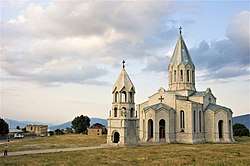Holy See of Cilicia
The Armenian Catholicosate of the Great House of Cilicia (Armenian: Կաթողիկոսութիւն Հայոց Մեծի Տանն Կիլիկիոյ) is an autocephalous Oriental Orthodox church.[1] Since 1930, the Catholicosate of the Great House of Cilicia has been headquartered in Antelias, Lebanon. Aram I is the Catholicos of Cilicia of the Armenian Apostolic Church since 1995.
| Catholicosate of the Great House of Cilicia Holy See of Cilicia | |
|---|---|
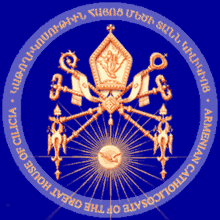 The coat of arms of the Catholicosate of the Great House of Cilicia | |
| Classification | Oriental Orthodox |
| Primate | Catholicos Aram I |
| Language | Armenian |
| Headquarters | Antelias, Lebanon previously Sis, Turkey |
| Territory | Cilicia & Western Armenia |
| Possessions | Middle East, Europe, North America, South America, Oceania, and Africa. |
| Founder | The Apostles Bartholomew and Thaddeus |
| Independence | Apostolic Era |
| Recognition | by Armenian Apostolic Church as an autocephalous church |
| Members | 4,000,000 |
| Official website | Armenian Catholicosate of the Great House of Cilicia |
| Part of a series on |
| Oriental Orthodoxy |
|---|
 |
| Oriental Orthodox churches |
|
Subdivisions
|
|
History and theology
|
|
Major figures
|
|
|
| Saint Gregory the Illuminator Cathedral | |
|---|---|
Սուրբ Գրիգոր Լուսաւորիչ մայր տաճար | |
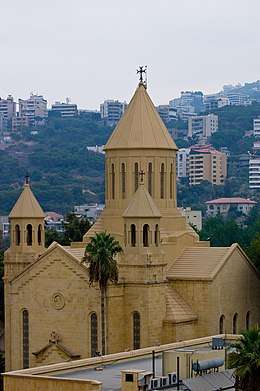 Saint Gregory the Illuminator Cathedral in the Armenian Catholicosate of Cilicia | |
| Religion | |
| Affiliation | Armenian Apostolic Church |
| District | Matn District |
| Province | Mount Lebanon |
| Region | Lebanon |
| Rite | Armenian Apostolic Rite |
| Ecclesiastical or organizational status | Catholicosate, Church Headquarters, Cathedral |
| Leadership | Catholicos Aram I |
| Year consecrated | 1930 |
| Status | Active |
| Location | |
| Location | Antelias, |
| Municipality | Antelias |
 Shown within Lebanon | |
| Geographic coordinates | 33.918275°N 35.585328°E |
| Architecture | |
| Style | Armenian |
| Completed | 1930 |
| Website | |
| http://www.armenianorthodoxchurch.org/ | |
Great House of Cilicia eras
- First Sis era, 267-301: According to the order of Catholicoi, *St. Gregory I the Enlightener (also known as Gregory the Illuminator) was seated in Sis 267-301 before moving to Etchmiadzin in 301 where he continued in office until 325.
- In 485 AD, the Catholicosate was transferred to the new capital of Armenia Dvin. In the 10th century it moved from Dvin to Dzoravank and then to Aghtamar (927 AD), to Arghina (947 AD) and to Ani (992 AD)
- Sivas era, 1058–1062
- Tavbloor era, 1062–1066
- Dzamendav (Zamidia, now Zamantı) era, 1066–1116
- Dzovk (Present aka Island of Gölcük and under the lake of Hazar), era, 1116–1149
- Hromgla (now Halfeti) era, 1149–1293
- Second Sis era, 1293-1930 (with the Catholicosate of All Armenians returned to Etchmiadzin in 1441)
- Antelias, Lebanon era, since 1930 - having transferred there from Sis in Cilicia in the aftermath of the Armenian Genocide.
Early history of the Armenian Church
The origin of the Armenian Church dates back to the Apostolic age and according to the ancient tradition was established by St. Thaddeus and St. Bartholomew. In 301 AD, Christianity was officially accepted by the Armenians as the state religion.[2]
St. Gregory the Illuminator, the patron Saint of the Armenian Apostolic Church, and King Tiridates III of Armenia, the ruler of the time, played a pivotal role in the official Christianization of Armenia. St. Gregory the Illuminator became the organizer of the Armenian Church hierarchy. From that time, the heads of the Armenian Church have been called Catholicos and still hold the same title. St. Gregory chose as the site of the Catholicosate then the capital city of Vagharshapat, in Armenia. He built the pontifical residence next to the church called "Holy Mother of God" (which in recent times would take on the name of Holy Etchmiadzin).
In 485 AD, the Catholicosate was transferred to the new capital Dvin. In the 10th century it moved from Dvin to Dzoravank and then to Aghtamar (927 AD), to Arghina (947 AD) and to Ani (992 AD).
Early era of the Catholicosate in Cilicia (1058–1293)
After the fall of Ani and the Armenian Kingdom of Bagradits in 1045, masses of Armenians migrated to Cilicia. The Catholicosate, together with the people, settled there. The seat of the church (now known as The Catholicosate of the Great House of Cilicia) was first established in Sivas (1058 AD) moving to Tavbloor (1062 AD), then to Dzamendav (1066 AD), Dzovk (1116 AD), Hromgla (1149 AD), and finally in Sis (1293), the capital of the Cilician Kingdom.
After the fall of the Armenian Kingdom of Cilicia, in 1375, the Church also assumed the role of national leadership, and the Catholicos was recognized as Ethnarch (Head of Nation). This national responsibility considerably broadened the scope of the Church's mission.
Two Catholicosates starting in 1441 AD
In 1441, a new Catholicos of All Armenians was elected in Holy Etchmiadzin in the person of Kirakos I Virapetsi of Armenia. At the same time the retiring Catholicos in Sis Gregory IX Mousabegian (1439–1446) remained as the Catholicos of the Great House of Cilicia. Therefore, since 1441, there have been two Catholicosates in the Armenian Apostolic Church with the primacy of the Catholicosate of All Armenians in the Mother See of Holy Etchmiadzin recognized by the Catholicosate of the Great House of Cilicia. The Supreme Patriarch and Catholicos of All Armenians resides in the Mother See of Holy Etchmiadzin.
Catholicosate in Sis (1293–1930)
The city of Sis (modern-day Kozan, Adana, Turkey) was the center of the Catholicosate of the Great House of Cilicia for more than six centuries, starting in 1293 when the Catholicosate moved from Hromgla to Sis. The monastery of St. Sophia of Sis, home of the Catholicosate, dominates the town in early 20th-century photographs. During the Armenian Genocide, in 1915, the Armenian population in Cilicia was mostly destroyed.[3] The last Catholicos to reside in Sis was Sahak II (Catholicos from 1902 to 1939). In 1921, after renewed massacres of Armenians in Cilicia by Kemalist Turkey, Sahak II, with the surviving Armenian population, fled to find refuge in Syria.
Catholicosate in Antelias, Lebanon (1930–present)
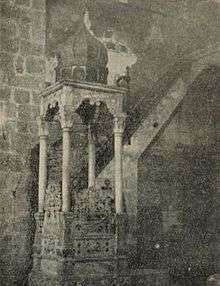
Sahak II after leaving the premises of the Catholicosate in Sis stayed at various locations in Northern Syria and in Lebanon, running the affairs of the Catholicosate.
In 1922 the American Committee for Relief in the Near East established an orphanage in Antilias for survivors of the genocide. It continued operating until 1928. After the foundation's Executive Committee was petitioned in 1929 by Sahak II, in 1930 the now-vacant buildings of the orphanage were leased to the Cilicia Catholicosate for a period of five years to be used as a seat for the Catholicosate and a seminary for training priests and teachers. The foundation also agreed to contribute $6000-$7000 yearly towards running costs.[4] The first mass in the Catholicosate's seminary at Antelias took place on Sunday, October 12, 1930.
Using donations from Simon and Mathilde Kayekjian, the Catholicosate eventually purchased the property and land that housed the Catholicosate in Antelias. Ailing Catholicos Sahak II, who died in 1939, was aided in his later years by Papken I, who served as Catholicos Coadjutor from 1931 until his death in 1936.
The St. Gregory the Illuminator Cathedral was built through the donation of a benefactor whose name, Sarkis Kenadjian, was only revealed after his death, according to his wish. A chapel in memory of the one and a half million Armenian martyrs was also built, followed by a residence for the Catholicos, called Veharan (Վեհարան), and a new Seminary building. The chapel was built after the donation of Armenian-Cypriot benefactor and art collector Vahram Utidjian, son of Apisoghom Utidjian, official translator for the British government in Cyprus. However, the "Cilicia" museum is a much later development; it was built and inaugurated in 1997.
Thus, the complex of the Catholicosate of the Great House of Cilicia in Antelias includes:
- St. Gregory the Illuminator Cathedral (1940)
- The Catholicosate Library (1932)
- "Cilicia" church museum (1997)
- Memorial chapel to the victims of the Armenian Genocide.
- The Catholicos' residence.
The Catholicosate complex also includes the mausoleum / cemetery where members of the Antelias congregation are buried. For a certain period, the Catholicosate also hosted an elementary Armenian school within the Catholicosate complex, but the school was moved to a new location a few kilometers away due to the expanding number of students and grade levels, as well as the need for additional classroom space.
The theological seminary located in the nearby mountains in Bikfaya also serves as summer residence for the Catholicos and the clergy.
Publications
Hask
The Catholicossate has its own publishing house and has a number of publications, most notably the monthly "Hask" (in Armenian Հասկ), the official organ of the Holy See of Cilicia.
Others
The Catholicosate also publishes a great number of books in Armenian and other languages, mainly on church literature as well as Armenian historical, cultural and literary subjects and series/collections of important Armenian literature.
The Catholicosate of the Great House of Cilicia also organizes an annual book fair on the occasion of Feast of the Holy Translators (known also as Surb Tarkmantchats), an official holiday on the calendar of the Armenian Apostolic Church to commemorate the legacy of the translators of the Bible and other Christian religious books to Armenian language in the 5th century.
Hask Armenological Review
It also publishes the annual "Hask Armenological Review" (in Armenian Հասկ Հայագիտական Հանդէս) on Armenian studies
Prelacies and Dioceses, and Churches
(in parenthesis, the residence of the Prelate / Archbishop / Bishop)
- United States of America
- Armenian Apostolic Prelacy of Eastern United States of America in New York
- Connecticut
- Saint Stephen's Armenian Apostolic Church, New Britain, CT
- Washington, D.C.
- Florida
- Holy Cross Armenian Apostolic Church, Kissimmee, FL
- Illinois
- Massachusetts
- St. Gregory Armenian Apostolic ChurchIndian Orchard, MA
- St. Gregory Armenian Apostolic Church of Merrimack Valley, North Andover, MA
- St. Stephen's Armenian Apostolic Church, Watertown, MA
- St. Asdvadzadzin Armenian Apostolic Church, Whitinsville, MA
- Holy Trinity Armenian Apostolic Church, Worcester, MA
- Michigan
- New Jersey
- New York
- St. Illuminators Armenian Apostolic Cathedral, New York, NY
- St. Sarkis Armenian Apostolic Church, Douglaston, NY
- Holy Cross Armenian Apostolic Church, Troy, NY
- St. John the Baptist Armenian Apostolic Church, Jamesville, NY
- St. Hagop Armenian Apostolic Church, Niagara Falls, NY
- Ohio
- Holy Cross Armenian Apostolic Church
- Pennsylvania
- Rhode Island
- Wisconsin
- St. Hagop Armenian Apostolic Church
- Connecticut
- Armenian Prelacy of Western United States of America in Los Angeles
- California
- Armenian Apostolic Church of Crescenta Valley, Crescenta Valley, CA
- Holy Martyrs Armenian Apostolic Church, Encino, CA
- Holy Trinity Armenian Apostolic Church, Fresno, CA
- St. Mary's Armenian Apostolic Church, Glendale, CA
- St. Garabed Armenian Apostolic Church, Hollywood, CA
- Holy Cross Armenian Apostolic Church, Montebello, CA
- St. Sarkis Armenian Apostolic Church, Pasadena, CA
- St. Gregory Armenian Apostolic Church, San Francisco, CA
- Forty Martyrs Armenian Apostolic Church of Orange County, Santa Ana, CA
- Nevada
- California
- Armenian Apostolic Prelacy of Eastern United States of America in New York
- Canada
- Armenian Prelacy of Canada
- Quebec
- Sourp Hagop Armenian Apostolic Cathedral, Montreal, Quebec
- Sourp Kevork Armenian Apostolic Church, Laval des Rapides, Quebec
- Ontario
- St. Mary Armenian Apostolic Church, Toronto, Ontario
- Sourp Nishan Armenian Apostolic Church, Cambridge, Ontario
- St. Paul Armenian Apostolic Church, St. Catharines, Ontario
- British Columbia
- St. Gregory the Illuminator Armenian Apostolic Church, Vancouver, British Columbia
- Quebec
- Armenian Prelacy of Canada
- Lebanon
- Syria
- Armenian Diocese of Beroea, in Aleppo
- Armenian Diocese of Jezireh, in Qamishli
- Cyprus
- Armenian Diocese of Cyprus, in Nicosia
- Nicosia
- Sourp Asdvadzadzin church (1981).
- Old Sourp Asdvadzadzin church (1308), as of 1964 under Turkish occupation.
- Sourp Boghos chapel (1892).
- Sourp Haroutiun chapel (1938).
- Sourp Amenapergitch chapel (1995).
- Halevga
- Sourp Magar monastery (1425), as of 1974 under Turkish occupation.
- Famagusta
- Ganchvor church (1346), as of 1964 under Turkish occupation.
- Larnaca
- Sourp Stepanos church (1909).
- Limassol
- Sourp Kevork church (1939).
- Nicosia
- Armenian Diocese of Cyprus, in Nicosia
- Greece
- Armenian Diocese of Greece, in Athens
- Iran
- Persian Gulf
- Armenian Diocese of Kuwait, in Kuwait City
- Armenian Diocese of the United Arab Emirates and Qatar, in Abu Dhabi
Gallery
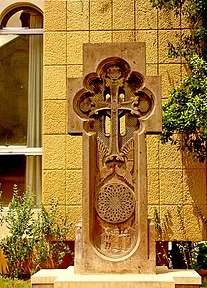 A khatchkar on the premises
A khatchkar on the premises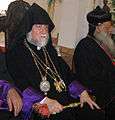
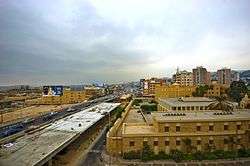 Partial view of the Catholicosate complex on the Mediterranean Sea in Antelias
Partial view of the Catholicosate complex on the Mediterranean Sea in Antelias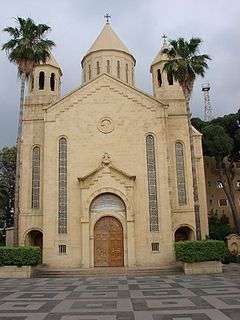 Saint Gregory the Illuminator Cathedral (1940)
Saint Gregory the Illuminator Cathedral (1940) Interior of the St. Gregory the Illuminator Cathedral
Interior of the St. Gregory the Illuminator Cathedral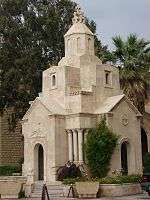 Memorial chapel to the Armenian Genocide at the Catholicosate premises in Antelias
Memorial chapel to the Armenian Genocide at the Catholicosate premises in Antelias
- Holy Mother of God Church (Sourp Asdvadzadzin) at the seminary in Bikfaya
See also
References
- "Frequently Asked Questions on the Cilician See of the Armenian Apostolic Church / Georgy S Thomas". Malankara Orthodox TV. 3 October 2017. Retrieved 2020-01-01.
- Herszenhorn, David M. (October 3, 2013). "Armenian Church, Survivor of the Ages, Faces Modern Hurdles" – via NYTimes.com.
- "Documents 119-129. Bryce. Armenians. XV---Cicilia (Vilayet of Adan and Sankjak of Marash)". net.lib.byu.edu.
- Anon, "The Armenian Catholicosate of Cilicia", Boston 1948.
Sources
- Stopka, Krzysztof (2016). Armenia Christiana: Armenian Religious Identity and the Churches of Constantinople and Rome (4th-15th century). Kraków: Jagiellonian University Press.CS1 maint: ref=harv (link)
